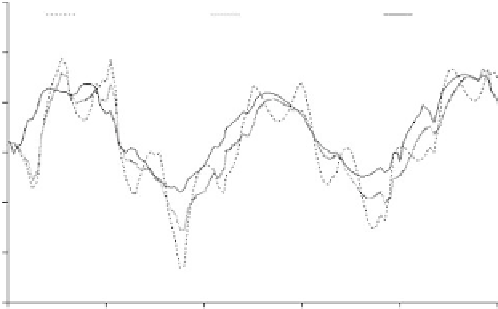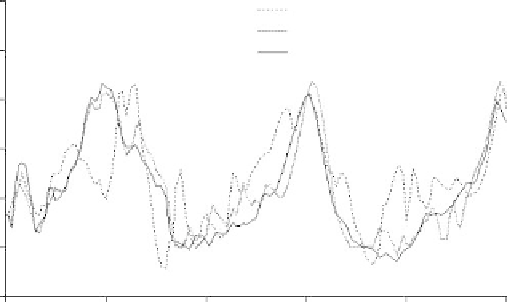Biomedical Engineering Reference
In-Depth Information
model, the maximum facet contact force of the denucleated model was 2.18 times greater
(case 1). Obviously, the removal of the nucleus leads to a greater static facet contact force
(Guo and Teo 2006).
The dynamic maximum facet contact forces of the intact model with damping were 11.2 N
for a damping ratio of 0.08 (case 4) and 10.7 N for a damping ratio of 0.15 (case 5). Damping
may decrease the amplitude of vibration and alleviate the extent of vibration of the lumbar spine.
The maximum facet contact force of the intact model with a 0.08 damping ratio (case 4) reached
0.746 times that of case 1, and the maximum force of the intact model with a 0.15 damping ratio
(case 5) reached 0.506 times that of case 1 (Figure 15.10a and Table 15.4).
However, from Figure 15.10b, it can be found that the damping did not have the same effects on
the denucleated models; the peak values are similar across all denucleated models.
Data about displacement and stress were acquired from the dynamic simulations for further
analysis. The plots of predicted stress and bulging of the L4-L5 disc as a function of time revealed
a cyclic response, with some fluctuations and distortions, as shown in Figures 15.11 and 15.12.
14
intact/no damp
intact/no damp
intact/damp 0.08
intact/damp 0.08
intact/damp
intact/damp 0.15
12
10
8
6
4
2
0
0.1
0.2
0.3
0.4
0.5
Time (s)
(a)
40
denucleated/no damp
denucleated/damp 0.08
denucleated/damp 0.15
35
30
25
20
15
10
0
0.1
0.2
0.3
0.4
0.5
Time (s)
(b)
FIgure 15.10
The dynamic responses of facet contact force in the finite element models with damping
under 5-Hz axial cyclic loads of 40 N for intact and denucleated models: (a) for intact models with different
damping ratios of 0.0, 0.08, and 0.15; (b) for denucleated models with different damping ratios of 0.0, 0.08.
and 0.15.





Search WWH ::

Custom Search